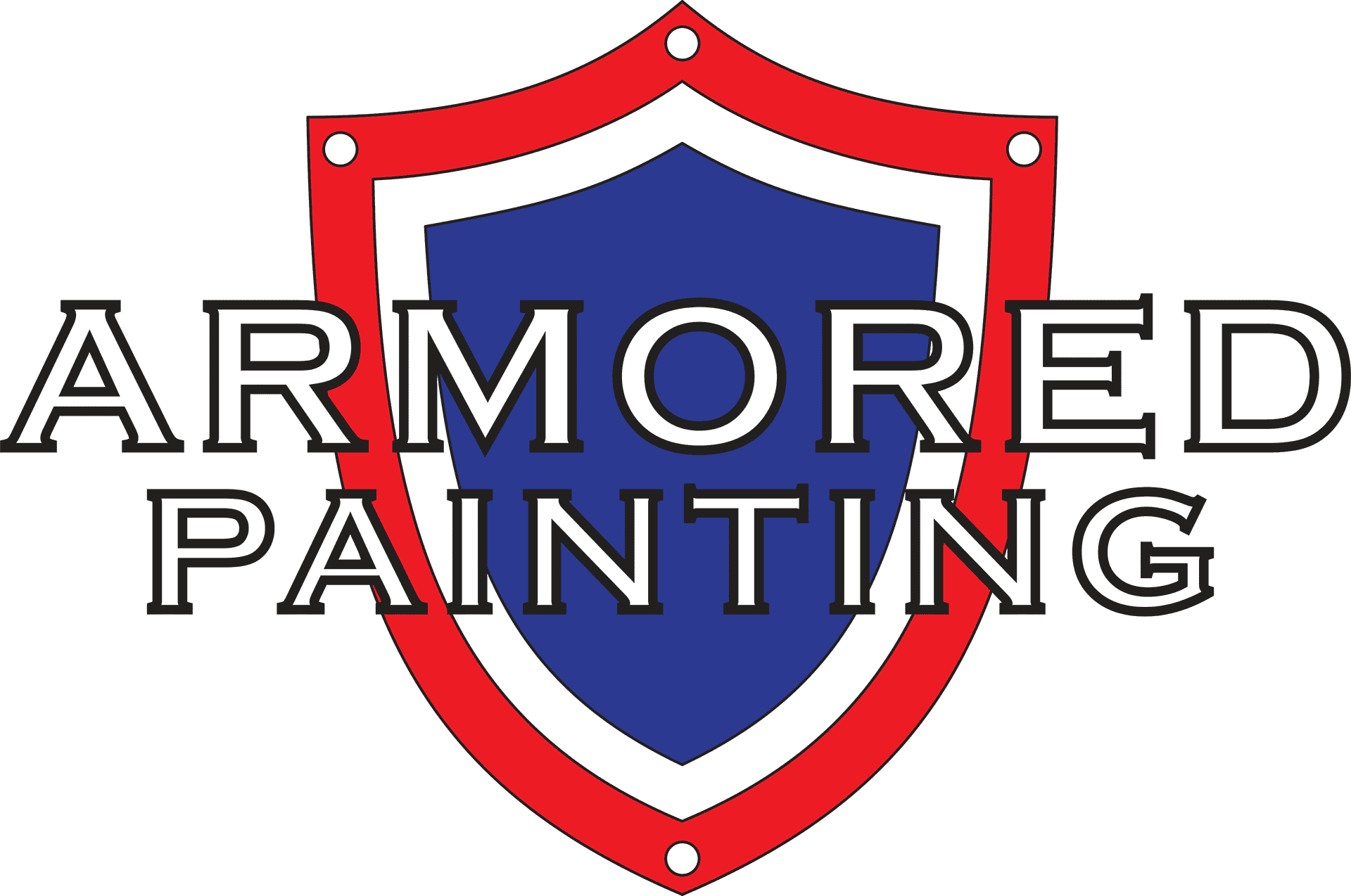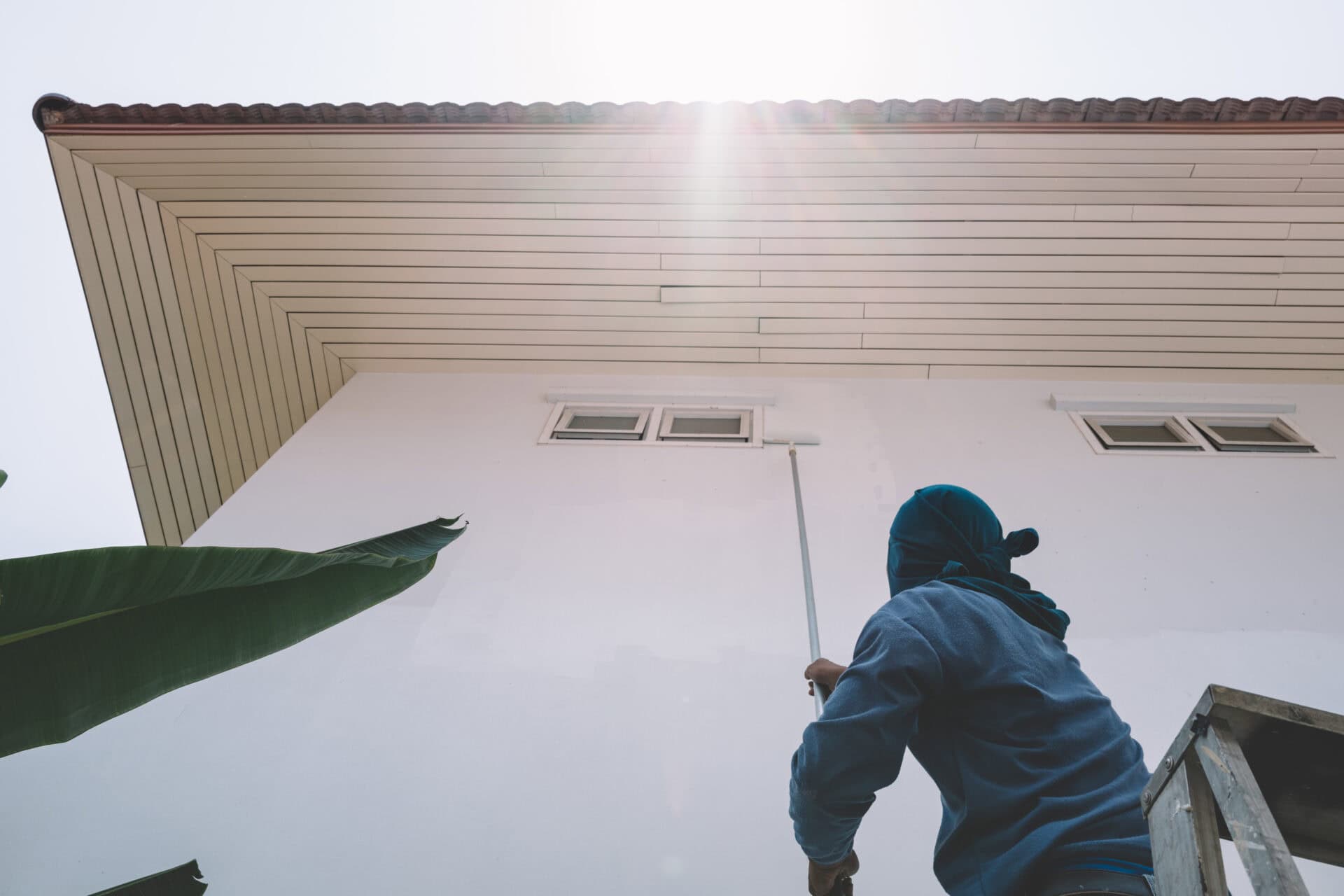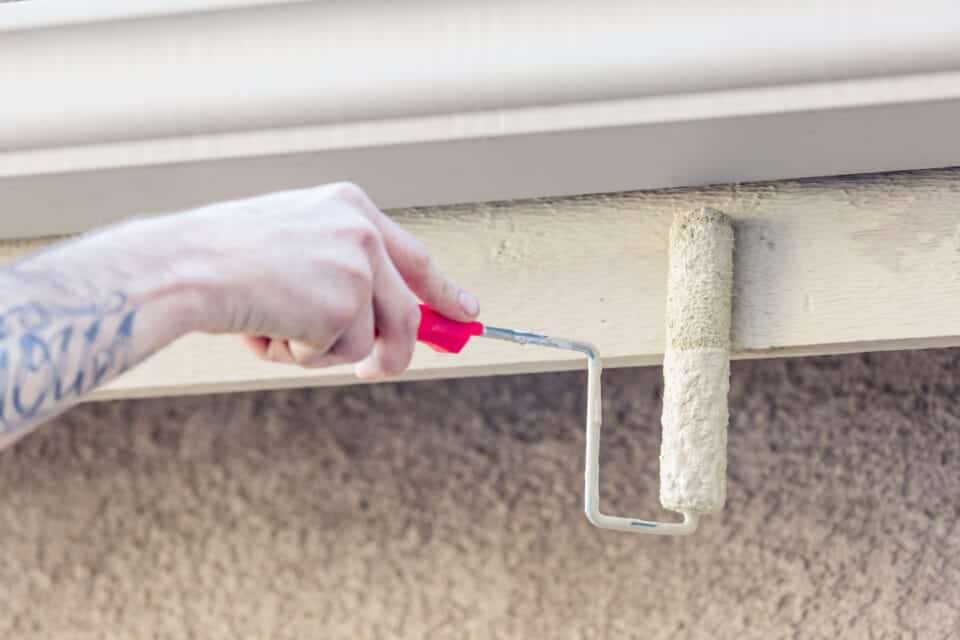Every homeowner’s exterior painting dilemma: Is it better to spray or roll exterior paint? This common question resonates time and again when it’s time for an exterior paint job. It’s a bit like choosing between a fast-food drive-thru and a sit-down meal.
Spray painting, like a drive-thru, offers speed and convenience. It’s great for covering large areas quickly and reaching those tight spots. But roll-on paint, similar to a sit-down meal, can provide a thicker, potentially more durable coat, giving your exterior that pristine, well-groomed look. Whether you’re dealing with wood siding or other surfaces, we’ll help you navigate this ‘spray or roll’ conundrum to achieve the best exterior paint application.
Key Takeaways
- Spray painting is faster and efficiently covers large areas, but can be trickier to control for beginners.
- Roll-on painting provides thicker, more durable coats, though it’s more time-consuming and physically demanding.
- Spray painting is ideal for smooth surfaces like wood siding, while roll-on painting works better for textured surfaces.
- Hiring professionals can combine the benefits of both methods, using sprayers for larger areas and rollers for detailed work.
- The longevity of the paint job depends more on the quality of paint and application technique than the method used.
Advantages and Disadvantages of Spray Painting
Spray painting offers a unique set of advantages and disadvantages compared to other methods like rolling, especially when it comes to exterior painting. Understanding these can help you decide whether it’s the right choice for your project.
One of the key advantages of spray painting is its efficiency. The application process is much faster compared to rolling, allowing you to cover large areas quickly and with fewer coats. This can be particularly beneficial for extensive exterior surfaces, such as walls or fences, where time is a critical factor. Additionally, spray painting provides a smooth and even finish that can be difficult to achieve with rollers, especially on textured or uneven surfaces. The fine mist of paint produced by the spray gun allows for better coverage in hard-to-reach areas and creates a more uniform coat.
Another advantage is the reduced physical effort required. Unlike rolling, which involves repetitive motion and can be physically taxing, spray painting requires less manual labor. This can be especially advantageous for large projects or for individuals who may have physical limitations.
However, spray painting also comes with its drawbacks. One major disadvantage is the potential for overspray. Because the paint is atomized into fine droplets, it can drift and settle on unintended surfaces, leading to wasted paint and potential cleanup challenges. This overspray can also affect nearby objects or areas, requiring careful masking and protection.
The need for proper ventilation is another consideration. Spray painting generates a significant amount of fumes and requires adequate airflow to ensure safety. This may not be ideal for all environments, particularly in enclosed spaces or areas with poor ventilation.
Additionally, achieving consistent coverage can be challenging for beginners. Spray painting requires a steady hand and practice to avoid runs or uneven areas. Without proper technique, you might end up with a finish that is less than perfect, requiring additional touch-ups or coats.
In terms of cost, spray painting can be more expensive due to the need for specialized equipment, such as spray guns and protective gear. There is also the potential for increased paint consumption due to overspray, which can add to the overall expense.
In summary, spray painting offers a fast and efficient way to cover large exterior areas with a smooth finish, but it also presents challenges such as overspray and the need for proper ventilation. Weighing these advantages and disadvantages will help you determine if spray painting is the best choice for your exterior painting project.
Advantages and Disadvantages of Roll-On Painting
Roll-on painting is a traditional method that offers both benefits and limitations when compared to spray painting, particularly for exterior surfaces. Understanding these can help you decide which method best suits your project needs.
One of the primary advantages of roll-on painting is its simplicity and control. This method involves using a paint roller to apply paint directly to the surface, which allows for precise application and easier management of paint thickness. Roll-on painting is well-suited for detailed work and smaller areas where accuracy is crucial. The roller can effectively cover textured surfaces and corners, ensuring even coverage and reducing the risk of drips or runs.
Cost is another benefit. Roll-on painting generally requires less specialized equipment compared to spray painting. A good quality roller, tray, and extension pole are relatively affordable and widely available. This makes roll-on painting a cost-effective choice, especially for smaller projects or for those on a budget.
Additionally, roll-on painting tends to produce less mess compared to spray painting. Since the paint is applied directly to the surface without being atomized into fine droplets, there is less risk of overspray affecting surrounding areas. This can make cleanup easier and reduce the need for extensive masking and protection of nearby surfaces.
However, roll-on painting does have its disadvantages. One significant drawback is the time required to complete the job. Applying paint with a roller is generally slower than spraying, particularly for large exterior surfaces. The process involves applying multiple coats to achieve even coverage, which can be labor-intensive and time-consuming.
Roll-on painting also requires more physical effort. The repetitive motion of rolling paint, especially on large surfaces, can be tiring and physically demanding. This can be a concern for those undertaking large projects or individuals who may have physical limitations.
Achieving a perfectly smooth finish can also be challenging with roll-on painting. While rollers can provide good coverage, they sometimes leave visible texture patterns, which may require additional touch-ups or sanding for a flawless appearance. This is especially true on rough or uneven surfaces where the roller may not reach into all the crevices as effectively as a spray gun.
In terms of paint usage, roll-on painting can be less efficient than spraying. Rollers tend to absorb and hold paint, which can lead to higher paint consumption, especially if multiple coats are needed. This can result in higher material costs and more frequent refilling of the roller tray.
In summary, roll-on painting offers control, cost-effectiveness, and less mess, but it comes with challenges such as slower application time, physical effort, and potential texture issues. Evaluating these factors will help you determine if roll-on painting is the right choice for your exterior painting project.
Analyzing the Effectiveness of Both Methods on Wood Siding
Diving into the performance of both painting techniques, a couple of interesting points stand out. By opting for spray painting, you’ll achieve a uniform finish, which is perfect for smooth surfaces like wood siding. However, be aware that this technique can be somewhat tricky to manage, especially if you’re a beginner. To overcome this, back-rolling might be an effective solution to enhance adhesion, using the paint sprayer for its speed and rolling to ensure the paint sticks well.
Switching gears to roll-on painting, the picture gets a bit more textured, quite literally! This method is particularly useful for textured surfaces, as the roller ensures that paint gets into every nook and cranny. However, rolling exterior paint might require a bit more elbow grease, as it generally necessitates multiple coats to achieve even coverage.
When it comes to the ultimate question – ‘is it better to spray or roll exterior paint?’ – the answer isn’t straightforward. Each method has its strengths and weaknesses, and the best approach often depends on the specific circumstances of your painting project.
For instance, if speed and efficiency are high on your priority list, then a paint sprayer could be your best bet. However, keep in mind that this might also lead to higher costs, as spray painting typically requires more equipment and uses more paint.
On the flip side, if you’re just getting started and want an easier, more cost-effective process, you might want to go for brush and roll. Although it’s more physically demanding and slower, it’s generally cheaper and could yield more durable results due to the thicker coats.
The longevity of your paint job doesn’t solely depend on the method you choose. It’s also about paint quality and proper application techniques. So, whether you decide to spray or brush, remember that the details also matter.
Moreover, don’t forget to consider environmental factors. While both methods have their environmental impacts, spray methods tend to produce more overspray and paint waste. So, if you’re concerned about your environmental footprint, this could be a factor in your decision.
In the end, whether you’re planning a DIY project or hiring professionals, the choice between spray painting and roll-on painting should be based on your unique needs, budget, and the type of surface you’re working on. So, weigh your options carefully.
Hiring Professionals for Exterior Painting
Enlisting experts for outdoor paint jobs is a viable option for many homeowners. But the debate continues: is it better to spray or roll exterior paint? Let’s dive into this.
Spray painting wins when it comes to speed and efficiency. It can reach tight corners with ease, ensuring a smooth finish with fewer coats. However, controlling the overspray can be tricky and the equipment can be expensive. Not to mention, it can consume more paint.
In contrast, roll-on painting is beginner-friendly. It’s cheaper as it requires fewer tools and less paint. Also, it provides thicker coats, making it potentially more durable. But it’s physically demanding, slower, and achieving consistent coverage can be challenging.
When painting wood siding, the choice between spray painting and roll-on painting becomes more nuanced. Spray painting provides a uniform finish, perfect for smooth surfaces. Roll-on painting, however, excels on textured surfaces, ensuring paint gets into every nook and cranny. Yet, it may require multiple coats for even coverage.
When considering a do-it-yourself approach versus hiring a professional for an exterior painting project, several factors come into play. The costs associated with both methods, including tools and labor, should be thoughtfully evaluated.
Professionals often combine both spray painting and roll-on methods to achieve optimal results. They use sprayers for covering large areas swiftly and rollers for the meticulous detail work. This blend of techniques is an effective solution for the ‘spray or brush’ dilemma.
No matter the method, the longevity of the paint job largely depends on the quality of paint used and the application techniques employed. It’s not just about whether you ‘brush and roll’ or use a ‘paint sprayer’. What matters is the care and precision you dedicate to the task.
Lastly, we mustn’t forget the environmental impacts of our choices. Though both methods have their environmental implications, spray painting tends to produce more overspray and paint waste. So, if you’re concerned about reducing your environmental footprint, this might tip the scales in favor of roll-on painting.
To sum up, the choice between spray painting and roll-on painting isn’t black and white. Each method has its pros and cons, and the best choice often depends on the specific project at hand. Whether you choose to wield a brush, roll, or spray, hiring a professional can ensure a high-quality, durable finish for your home’s exterior.
Choosing the Best Method for a Flawless Finish: Spray or Roll?
In the debate of whether it’s better to spray or roll exterior paint, both methods have their merits, but the right choice depends on your specific project needs. Spraying offers speed and a smooth, even coat, ideal for large surfaces and intricate details. Rolling, on the other hand, provides greater control and is perfect for smaller areas or detailed work. Understanding the advantages and limitations of each method allows you to select the most effective approach for achieving a professional and durable finish.
For those who want to ensure a top-notch exterior paint job without the hassle of choosing the right technique themselves, Armored Painting is here to help. Specializing in exterior painting services, Armored Painting combines expert knowledge with high-quality materials to deliver exceptional results. Our team can assess your project, recommend the best application method, and execute the job with precision and care.
By choosing Armored Painting, you’re investing in a hassle-free experience with a finish that not only looks great but also stands up to the elements. Whether you opt for spraying or rolling, our expertise ensures that your home’s exterior will be beautifully and professionally painted.
In conclusion, while both spraying and rolling have their distinct advantages, partnering with Armored Painting for our professional exterior painting services guarantees that you’ll receive expert advice and top-quality service tailored to your project’s needs. Let our skilled team handle the details, so you can enjoy a stunning, long-lasting exterior paint job with peace of mind. Contact us today to know more.




